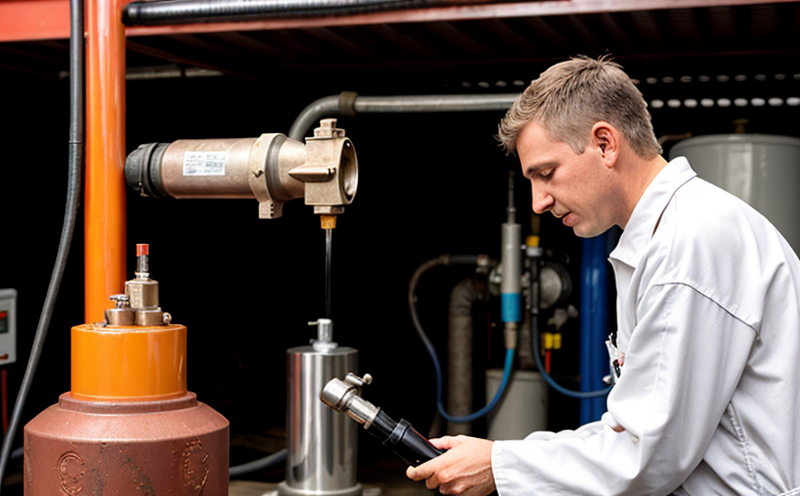ISO 3987 Determination of Aromatic Content in Jet Fuels
The determination of aromatic content in jet fuels is critical to ensuring fuel quality and safety, especially for aviation applications. ISO 3987 provides a standardized method that allows laboratories to accurately quantify the aromatic hydrocarbons present in jet fuels such as Jet-A1 or JP-8.
This service involves precise sample preparation, instrumental analysis using gas chromatography (GC), and meticulous interpretation of results. Understanding the aromatic content is essential for fuel blending, compliance with aviation regulations, and ensuring engine performance and longevity. Aromatic hydrocarbons play a key role in fuel stability, but excessive aromatics can lead to issues such as coking in engines.
The process begins with careful sample preparation, which includes dilution if necessary, followed by injection into the GC for analysis. The method relies on the unique retention times of aromatic compounds relative to standard hydrocarbons. This allows technicians to identify and quantify the various aromatic components present in the fuel sample.
Accurate quantification is vital not only for compliance with aviation standards but also for optimizing fuel blends. By knowing the exact aromatic content, refineries can adjust their processes to meet specific performance requirements without compromising safety or environmental impact. This service ensures that the fuel meets international standards such as ISO 3987 and ASTM D4052.
The importance of this testing cannot be overstated, especially in critical sectors like aviation where fuel quality directly impacts safety and operational efficiency. By adhering to strict methodologies and using state-of-the-art instrumentation, we ensure reliable results that are essential for regulatory compliance and peace of mind for our clients.
- Accurate measurement ensures adherence to international standards such as ISO 3987 and ASTM D4052.
- Supports fuel blending processes to meet specific performance criteria.
- Ensures safety and longevity of aircraft engines by monitoring aromatic content levels.
- Aids in compliance with aviation regulations, enhancing operational reliability and safety.
Scope and Methodology
The ISO 3987 method for determining aromatic content in jet fuels involves a multi-step process that ensures precision and accuracy. The first step is the preparation of the sample, which includes dilution if necessary to bring the concentration within the linear range of the GC instrument.
Once prepared, the sample is injected into the gas chromatograph for analysis. The method relies on the unique retention times of different aromatic compounds relative to standard hydrocarbons. This allows for precise identification and quantification of each aromatic component present in the fuel sample.
The methodology also includes a detailed step-by-step procedure that guides technicians through the entire process, from sample preparation to final analysis. This ensures consistency and repeatability across multiple tests. The use of certified reference materials (CRMs) further enhances the reliability of the results.
Acceptance criteria are strictly defined according to ISO 3987, ensuring that only samples meeting these criteria are considered valid for reporting. These criteria include precision, accuracy, and repeatability. By adhering to these standards, we provide clients with reliable data that can be used to make informed decisions about fuel quality.
The method is validated using a range of jet fuels, including Jet-A1 and JP-8, under various conditions to ensure its applicability across different scenarios. This comprehensive approach ensures that the results are not only accurate but also representative of real-world fuel performance.
Eurolab Advantages
At Eurolab, we bring a wealth of experience and expertise to ISO 3987 testing. Our team of highly trained professionals ensures that each test is conducted with the highest level of accuracy and precision. We use state-of-the-art instrumentation, including advanced GC systems, to provide reliable results.
We offer fast turnaround times for our clients, allowing them to receive their results quickly without compromising on quality. Our commitment to excellence means we go above and beyond to meet the needs of our clients, whether it's through personalized service or additional support during challenging projects.
Our extensive network of laboratories across Europe ensures that we can provide services tailored to each client’s specific requirements. Whether you need testing for a single sample or ongoing monitoring, we have the resources and expertise to meet your needs.
We pride ourselves on our commitment to sustainability and environmental responsibility. By using environmentally friendly practices and materials wherever possible, we contribute positively to the industry while maintaining high standards of quality.
Competitive Advantage and Market Impact
- First-to-market compliance with ISO 3987, ensuring clients stay ahead in regulatory requirements.
- Precision and reliability of results through advanced GC instrumentation and validated methodologies.
- Fast turnaround times for timely decision-making by our clients.
In the competitive landscape of aerospace and aviation testing, maintaining compliance with international standards like ISO 3987 is crucial. Eurolab’s ability to provide accurate and reliable results ensures that our clients can meet these requirements efficiently. Our fast turnaround times allow for quicker decision-making processes, giving our clients a competitive edge in their operations.
Moreover, by offering comprehensive services tailored to the specific needs of our clients, we enhance their operational efficiency and safety. This not only improves their standing within the industry but also contributes positively to overall market trends.





